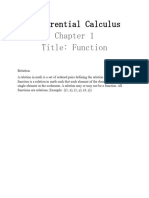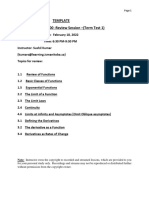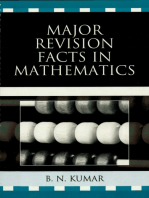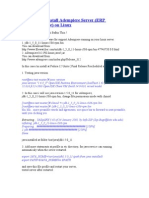Functions: y X F y X F
Uploaded by
Anne Julia AgustinFunctions: y X F y X F
Uploaded by
Anne Julia AgustinLIMITS AND CONTINUITY OF FUNCTIONS
1. FUNCTIONS
A function f from a set X to a set Y is a rule of correspondence that pairs to
each element x of X exactly one element y of Y. This correspondence can be
denoted by
Definition:
f :xy
or
f (x ) = y .
HISTORY
The idea of a function goes back to Sharaf al-Dn al-Ts, a Persian mathematician in the 12th century.
However, it was Gottfried Leibniz who coined term function in a 1673 letter to describe a quantity related
to a curve. The function described by Leibniz is now known as the differentiable function. This function
includes the concepts of limits and derivatives, which are the basis of calculus. During the mid-18th
century, the word function was used by Leonhard Euler to describe an expression or formula involving
various arguments.
DOMAIN AND RANGE OF A FUNCTION
The domain of the function f, denoted by dom f or D f , is the whole set of permissible values of x. While
its range, denoted by ran f or R f , is the set of corresponding elements of y.
COMMON TYPES OF FUNCTIONS
The following is a list of common functions, describing their forms, graph, domain, and range.
1. Constant Function
Form:
Graph:
Domain:
Range:
where c
f (x ) = c ,
Horizontal line with y-intercept c
Set of real numbers, denoted as {x x }
{y y = c}
2. Linear Function
Form:
Graph:
Domain:
Range:
where m, b , m 0
f (x ) = mx + b ,
Line with slope m and y-intercept b
{x x }
{y y }
33 | Page
LIMITS AND CONTINUITY OF FUNCTIONS
3. Quadratic Function
Form:
Graph:
Domain:
Range:
f (x ) = ax 2 + bx + c , where a , b, c , a 0
Vertical parabola with the following properties
concave upward if a > 0 , or concave downward if a < 0
b 4ac b2
vertex at the point V ,
4a
2a
x-intercepts are the real zeroes or roots of the quadratic equation
ax 2 + bx + c = 0 , and y-intercept is c
{x x }
{y y y - component of the vertex} if the parabola is concave upward
{y y y - component of the vertex} if the parabola is concave downward
4. Polynomial Function of Degree n
Form:
Graph:
Domain:
Range:
f (x ) = an x n + an1 x n1 + L + a2 x 2 + a1 x + a0 , where a0 , a1 ,K , an , an 0
Vary from polynomial function to polynomial function
{x x }
Vary from polynomial function to polynomial function
5. Rational Function
Form:
Graph:
Domain:
Range:
f (x ) =
g (x )
,
h(x )
where f ( x ) and h(x ) are not constant functions, g (x ) and
h( x ) are polynomial functions, and h(x ) 0
Vary from rational function to rational function
asymptotic or has holes at the real zeroes of the denominator
The set of real numbers except the zeroes of h( x )
Vary from rational function to rational function
6. Radical Function
Form:
Graph:
Domain:
Range:
where n Z + , n 2
f (x ) = n g (x ) ,
Vary from radical function to radical function
{x x } if g(x ) is a polynomial function and n is odd
{x g(x ) 0} if g(x ) is a polynomial function and n is even
Vary from radical function to radical function
34 | Page
LIMITS AND CONTINUITY OF FUNCTIONS
7. Piecewise Function
Form:
Graph:
Domain:
Range:
g1 (x ) , x I1
g (x ) , x I
2
2
,
where I1 , I2 ,K , In are disjoint intervals of x
f (x ) =
M
M
gn ( x ) , x In
Vary from piecewise function to piecewise function
The union of the I1 , I2 ,K , In intervals, except the numbers at which any of the
functions g1 (x ), g2 (x ),K,gn ( x ) is undefined with respect to Ii , where i = 1,2,K, n
Vary from piecewise function to piecewise function
MISCELLANEOUS FUNCTIONS
1. Absolute Value Function
g (x ) , g( x ) 0
f (x ) = g( x ) =
m g ( x ) , g ( x ) < 0
Graph:
V-shaped, if linear, and opens upward if f (x ) = g(x ) , or opens downward if
f (x ) = g (x )
Domain:
{x x }
Range:
{y y y - value of the "corner"} if it is linear and opens upward
{y y y - value of the " corner"} if it is linear and opens downward
2. Greatest Integer Function
Form:
Form:
Graph:
Domain:
Range:
f (x ) = x = {the greatest integer x}
Step-like
{x x }
{y y Z}
3. Trigonometric Functions
Function
y = sin x
y = cos x
y = tan x
y = cot x
y = sec x
y = csc x
Domain
Range
{x x }
{x x }
{y 1 y 1}
{y 1 y 1}
x x k + , k Z
2
{y y }
{x x k , k Z}
{y y }
x x k + , k Z
2
{x x k , k Z}
{y y 1 or y 1}
{y y 1 or y 1}
35 | Page
LIMITS AND CONTINUITY OF FUNCTIONS
4. Natural Exponential Function and Other Exponential Functions
Form:
Graph:
Domain:
Range:
f (x ) = e x = exp( x )
f (x ) = a x
Has the following characteristics
has a horizontal asymptote at y = 0
y-intercept is 1
increasing if a > 1 or decreasing if 0 < a < 1
{x x }
{y y > 0}
5. Natural Logarithmic Funciton and Other Logarithmic Functions
Form:
Graph:
Domain:
Range:
f (x ) = ln(x )
f (x ) = log a x
Has the following characteristics
has a vertical asymptote at x = 0
x-intercept is 1
increasing if a > 1 or decreasing if 0 < a < 1
{x x > 0}
{y y }
36 | Page
LIMITS AND CONTINUITY OF FUNCTIONS
EXERCISES
Determine the domain and range of the following functions. Sketch their graphs.
1. f (x ) = 2 x 4
6. p(x ) =
x 2 2x 3
x 3
2. y = 8 2 x x 2
7. r (x ) =
x3 4x
x 2
3. y = ( x + 2)3
8. h(x ) =
x2
x2 1
4. y =
1
x
5. g( x ) =
9. y = 4 x 2
x 1
x +2
10. q (x ) = x 2 9
37 | Page
LIMITS AND CONTINUITY OF FUNCTIONS
11. f ( x ) = 3 x + 1
16. f (x ) = 9 x 2
12. g( x ) = x 2 + 4
17. y = x + 3 1
13. h(x ) =
x
x 1
18. y = x + 2
1 , x < 0
14. sgn( x ) = 0 , x = 0
1 , x >0
19. y =
1 x
15. y =
x 2
x2 4
20. f (x ) = x + 2
4x
, x <2
, x 2
x
x
x < 2
, 2 < x 2
,
x >2
38 | Page
You might also like
- Strapack I-10 Instruction-Parts Manual MBNo ratings yetStrapack I-10 Instruction-Parts Manual MB26 pages
- Functions and Limits: Animation 1.1: Function Machine Source and Credit: Elearn - PunjabNo ratings yetFunctions and Limits: Animation 1.1: Function Machine Source and Credit: Elearn - Punjab23 pages
- 3.1 Characteristics of Polynomial Functions: y - Intercept and The Constant TermNo ratings yet3.1 Characteristics of Polynomial Functions: y - Intercept and The Constant Term6 pages
- Computer Science Notes Mathematics For Computer ScienceNo ratings yetComputer Science Notes Mathematics For Computer Science38 pages
- QS015 - Chapter 5 Functions & Graphs PDFNo ratings yetQS015 - Chapter 5 Functions & Graphs PDF24 pages
- Representation of Functions: Aaron Paul A. CasabarNo ratings yetRepresentation of Functions: Aaron Paul A. Casabar78 pages
- MTH4100 Calculus I: Lecture Notes For Week 2 Thomas' Calculus, Sections 1.3 To 1.5No ratings yetMTH4100 Calculus I: Lecture Notes For Week 2 Thomas' Calculus, Sections 1.3 To 1.513 pages
- revalidated_MATH_GR8_QTR2-MODULE-4 (28pages)No ratings yetrevalidated_MATH_GR8_QTR2-MODULE-4 (28pages)28 pages
- Mathematics Gist Functions & Graphs CLASS XINo ratings yetMathematics Gist Functions & Graphs CLASS XI12 pages
- This PDF Is The Sample PDF Taken From Our Comprehensive Study Material For IIT-JEE Main & AdvancedNo ratings yetThis PDF Is The Sample PDF Taken From Our Comprehensive Study Material For IIT-JEE Main & Advanced13 pages
- MATH165 CO1 Lesson 1.8 Intro To FunctionsNo ratings yetMATH165 CO1 Lesson 1.8 Intro To Functions22 pages
- 1 Differential Calculus_241218_184823 (1)No ratings yet1 Differential Calculus_241218_184823 (1)81 pages
- (Meaning: X Values Can Never Repeat) : Vertical Line TestNo ratings yet(Meaning: X Values Can Never Repeat) : Vertical Line Test6 pages
- Section 1.1: Definition of Functions: Provided by Almae Matris Studiorum CampusNo ratings yetSection 1.1: Definition of Functions: Provided by Almae Matris Studiorum Campus19 pages
- Clinical Nutrition B Guide SY 2nd Sem 2022-2023 2No ratings yetClinical Nutrition B Guide SY 2nd Sem 2022-2023 2156 pages
- General Practice Physical Activity Questionnaire100% (1)General Practice Physical Activity Questionnaire1 page
- 3E - Agustin, Anne Julia - Group 1 - Case 7,8No ratings yet3E - Agustin, Anne Julia - Group 1 - Case 7,85 pages
- Í Egvxè Agustin Analynâââââââ H Ç+Âdî: Statement of AccountNo ratings yetÍ Egvxè Agustin Analynâââââââ H Ç+Âdî: Statement of Account2 pages
- Gurugram Bus Station: NCR Bus Time Schedule & Line MapNo ratings yetGurugram Bus Station: NCR Bus Time Schedule & Line Map7 pages
- School Physics Experiments With Arduino DUENo ratings yetSchool Physics Experiments With Arduino DUE29 pages
- Taxation: RC NRC RA Nraeb Nraneb SA On Taxable Income On Passive IncomeNo ratings yetTaxation: RC NRC RA Nraeb Nraneb SA On Taxable Income On Passive Income1 page
- Student Exploration: Roller Coaster PhysicsNo ratings yetStudent Exploration: Roller Coaster Physics3 pages
- (Petition) Filed Under Rule 45 of The Rules of CourtNo ratings yet(Petition) Filed Under Rule 45 of The Rules of Court11 pages
- Policy On The Organization and Implementation of The Special Program in Journalism (SPJ)No ratings yetPolicy On The Organization and Implementation of The Special Program in Journalism (SPJ)19 pages
- 5 Types of Fish Often Called As The 'Dragon Fish' by Eka RahmadhyNo ratings yet5 Types of Fish Often Called As The 'Dragon Fish' by Eka Rahmadhy3 pages
- Organisation Case Studies Letter of InvitationNo ratings yetOrganisation Case Studies Letter of Invitation2 pages
- Al Bahja Al Daema Shopping Center: Purchase OrderNo ratings yetAl Bahja Al Daema Shopping Center: Purchase Order2 pages
- Isolation and Quantification of Lycopene From Tomato Cultivated in Dezfoul, IranNo ratings yetIsolation and Quantification of Lycopene From Tomato Cultivated in Dezfoul, Iran7 pages
- GAIL (India) Limited: Advt. No. GAIL/Pata/MS/Contract/01/15 Engagement of Medical Professionals On Contract BasisNo ratings yetGAIL (India) Limited: Advt. No. GAIL/Pata/MS/Contract/01/15 Engagement of Medical Professionals On Contract Basis2 pages
- 01 Introduction To The Book of Daniel - 1No ratings yet01 Introduction To The Book of Daniel - 150 pages
- Functions and Limits: Animation 1.1: Function Machine Source and Credit: Elearn - PunjabFunctions and Limits: Animation 1.1: Function Machine Source and Credit: Elearn - Punjab
- 3.1 Characteristics of Polynomial Functions: y - Intercept and The Constant Term3.1 Characteristics of Polynomial Functions: y - Intercept and The Constant Term
- Computer Science Notes Mathematics For Computer ScienceComputer Science Notes Mathematics For Computer Science
- Representation of Functions: Aaron Paul A. CasabarRepresentation of Functions: Aaron Paul A. Casabar
- MTH4100 Calculus I: Lecture Notes For Week 2 Thomas' Calculus, Sections 1.3 To 1.5MTH4100 Calculus I: Lecture Notes For Week 2 Thomas' Calculus, Sections 1.3 To 1.5
- This PDF Is The Sample PDF Taken From Our Comprehensive Study Material For IIT-JEE Main & AdvancedThis PDF Is The Sample PDF Taken From Our Comprehensive Study Material For IIT-JEE Main & Advanced
- (Meaning: X Values Can Never Repeat) : Vertical Line Test(Meaning: X Values Can Never Repeat) : Vertical Line Test
- Section 1.1: Definition of Functions: Provided by Almae Matris Studiorum CampusSection 1.1: Definition of Functions: Provided by Almae Matris Studiorum Campus
- Í Egvxè Agustin Analynâââââââ H Ç+Âdî: Statement of AccountÍ Egvxè Agustin Analynâââââââ H Ç+Âdî: Statement of Account
- Gurugram Bus Station: NCR Bus Time Schedule & Line MapGurugram Bus Station: NCR Bus Time Schedule & Line Map
- Taxation: RC NRC RA Nraeb Nraneb SA On Taxable Income On Passive IncomeTaxation: RC NRC RA Nraeb Nraneb SA On Taxable Income On Passive Income
- (Petition) Filed Under Rule 45 of The Rules of Court(Petition) Filed Under Rule 45 of The Rules of Court
- Policy On The Organization and Implementation of The Special Program in Journalism (SPJ)Policy On The Organization and Implementation of The Special Program in Journalism (SPJ)
- 5 Types of Fish Often Called As The 'Dragon Fish' by Eka Rahmadhy5 Types of Fish Often Called As The 'Dragon Fish' by Eka Rahmadhy
- Isolation and Quantification of Lycopene From Tomato Cultivated in Dezfoul, IranIsolation and Quantification of Lycopene From Tomato Cultivated in Dezfoul, Iran
- GAIL (India) Limited: Advt. No. GAIL/Pata/MS/Contract/01/15 Engagement of Medical Professionals On Contract BasisGAIL (India) Limited: Advt. No. GAIL/Pata/MS/Contract/01/15 Engagement of Medical Professionals On Contract Basis





































































































